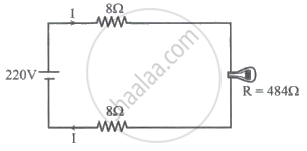Advertisements
Advertisements
प्रश्न
A servo voltage stabiliser restricts the voltage output to 220 V ± 1%. If an electric bulb rated at 220 V, 100 W is connected to it, what will be the minimum and maximum power consumed by it?
उत्तर
Output voltage, V = 220 V ± 1% = 220 V ± 2.2 V
The resistance of a bulb that is operated at voltage V and consumes power P is given by
\[R = \frac{V^2}{P} = \frac{(220 )^2}{100}\]
\[ \Rightarrow R = \frac{48400}{100} = 484 \Omega\]
(a) For minimum power to be consumed, output voltage should be minimum. The minimum output voltage,
V' = (220 − 2.2) V
= 217.8 V
The current through the bulb,
\[i' = \frac{V'}{R} = \frac{217 . 8}{484} = 0 . 45 A\]
Power consumed by the bulb, P' = i' × V'
= 0.45 × 217.8 = 98.0 W
(b) For maximum power to be consumed, output voltage should be maximum. The maximum output voltage,
V" = (220 + 2.2) V
= 222.2 V
The current through the bulb,
\[i'' = \frac{V''}{R} = \frac{222 . 2}{484} = 0 . 459 A\]
Power consumed by the bulb,
P" = i" × V"
= 0.459 × 222.2 = 102 W
APPEARS IN
संबंधित प्रश्न
What determines the rate at which energy is delivered by a current?
An electric motor takes 5 A from a 220 V line. Determine the power of the motor and the energy consumed in 2 h.
Which of the following terms does not represent electrical power in a circuit?
Write the formula for electric power in terms of potential difference and current.
An electric kettle for use on a 230 V supply is rated 3000 W. For safe working, the cable connected to it should be able to carry at least:
(a) 2 A
(b) 5 A
(c) 10 A
(d) 15 A
Why is an electric light bulb not filled with air? Explain why argon or nitrogen is filled in an electric bulb.
Distinguish between kilowatt and kilowatt-hour.
When a current I flows through a resistance R for time t, the electrical energy spent is given by:
(a) IRt (b) I²Rt (c) `IR^2t` (d) `I^2R ⁄t`
A current of 2 A is passed through a coil of resistance 75Ω for 2 minutes. (a) How much heat energy is produced? (b) How much charge is passed through the resistance?
A resistor of resistance R is connected to an ideal battery. If the value of R is decreased, the power dissipated in the resistor will ______________ .
An electric bulb of resistance 500 Ω draws current 0.4 A from the source. Calculate:
- the power of bulb and
- the potential difference at its end.
Two resistors A and B of 4 Ω and 6 Ω respectively are connected in parallel. The combination is connected across a 6 volt battery of negligible resistance. Calculate the power supplied by the battery.
A device is used to transform 12 V a.c. to 200 V a.c. What is the name of this device? Name the principle on which it works.
What do you understand by ‘earthing’? What are the advantages of earthing in a household electric circuit? Explain, how it is done?
Three 250 W heaters are connected in parallel to a 100 V supply, Calculate the resistance of each heater.
A 100-watt electric bulb is used for 5 hours daily and four 60 watt bulbs are used for 5 hours daily. Calculate the energy consumed (in kWh) in the month of January.
Using a long extension cord in which each conductor has a resistance of 8Ω, a bulb marked as '100 W, 200 V' is connected to a 220 V dc supply of negligible internal resistance as shown in the figure. The power delivered to the bulb is ______ W.

A conductor of 10 Ω is connected across a 6 V ideal source. The power supplied by the source to the conductor is ______.
